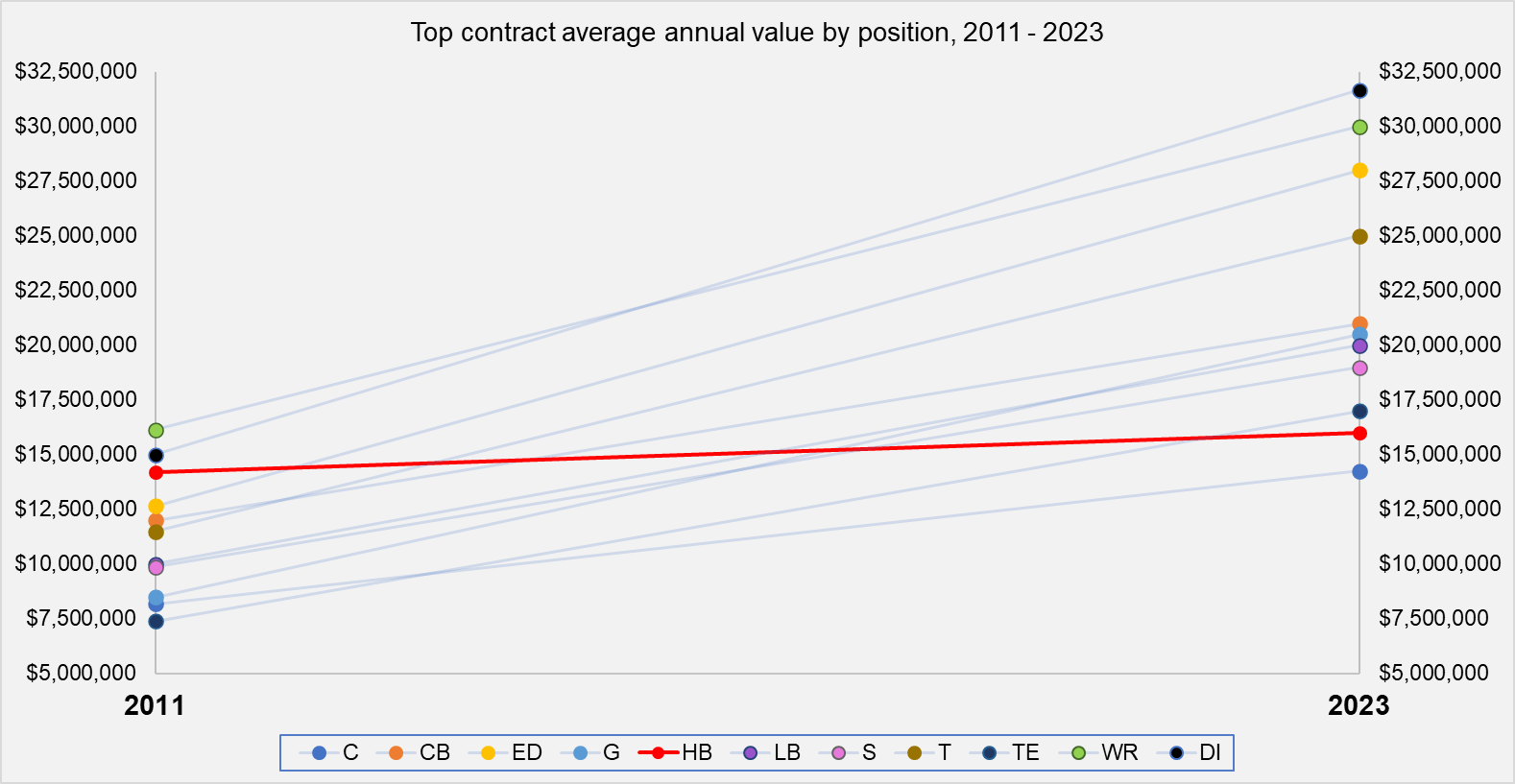- The RB market's lack of growth: The top of the running back market has grown by 12% since 2011, at least 60% less growth than every other position.
- Extension updates: Now roughly three weeks from the July 17th deadline, there doesn’t appear to be much progress toward extensions for Saquon Barkley or Josh Jacobs.
- Will the running back position start to see a material change in participation rates among top athletes at the high school, college or NFL level?
Estimated reading time: 6 minutes
The Minnesota Vikings let running back Dalvin Cook go just two years into a five-year, $63 million extension after back-to-back seasons with at least 1,150 rushing yards, 45 missed tackles forced and 30 explosive rushes, ranking top six among running backs in all three categories. If this level of production isn’t good enough to reach the third year of a market-rate extension, what will be good enough at the running back position?
Now, it’s not as if the decision was a complete surprise, and if we move away from volume stats, we see that Cook’s 24.1% stuff rate (percentage of rushes for a loss or no gain) led the NFL over the last two seasons. Since 2021, Cook’s 73.4 rushing grade ranks 49th out of 73 running backs with at least 100 carries over the span. Nevertheless, if Cook’s production isn’t good enough to sustain a second contract at 27 years old, it’s fair to wonder where the position market goes from here.
Another legendary Vikings running back, Adrian Peterson, signed a six-year, $85.28 million extension in 2011 worth $14.213 million per year. That average annual value to this day ranks fifth all-time at the position, and odds are it could stay that way for the foreseeable future. Only two other position groups have a top-five contract in terms of average annual value signed before 2020, as Aaron Donald and Khalil Mack signed monster extensions in 2018 that both rank fifth all-time among interior defenders and edge rushers, respectively. Neither will be in the top five by the end of this offseason.
The below chart illustrates the top contract in terms of average annual value at each position in 2011 and now:

The running back market has hardly grown at all at the top, below is how the percentage growth in the top average annual value contract looks by position:
| Position | Top Contract 2011 | Top Contract 2023 | Percent Growth |
| Quarterback | $18,000,000 | $52,000,000 | 288.89% |
| Guard | $8,500,000 | $20,500,000 | 241.18% |
| Tight end | $7,400,000 | $17,000,000 | 229.73% |
| Edge defender | $12,666,667 | $28,002,750 | 221.07% |
| Offensive tackle | $11,500,000 | $25,000,000 | 217.39% |
| Interior defender | $15,000,000 | $31,666,666 | 211.11% |
| Linebacker | $10,000,000 | $20,000,000 | 200.00% |
| Safety | $9,866,667 | $19,000,000 | 192.57% |
| Salary cap | $120,000,000 | $224,800,000 | 187.33% |
| Wide receiver | $16,142,857 | $30,000,000 | 185.84% |
| Cornerback | $12,000,000 | $21,000,000 | 175.00% |
| Center | $8,186,000 | $14,250,000 | 174.08% |
| Running back | $14,213,333 | $16,015,853 | 112.68% |
Christian McCaffrey’s extension (signed in 2020 for just over $16 million per year) is also the oldest deal in the right-hand column and not looking like it will be surpassed any time soon.
Why has it become so hard to get paid at running back?
Unfortunately, there isn’t some grand conspiracy here. The position's devaluation came from the league long before “analytics” truly carved out a stronghold in the public discourse. The aforementioned Adrian Peterson contract was an inflection point. The harsh reality is the results for top-paid running backs over the last decade have been largely poor, with a decline in production almost an inevitability on the second contract as compared to the rookie deal years.
Since 2011, 19 running backs signed a second contract for at least $7 million per year. Here is how they performed in aggregate across various key metrics over their first five seasons against their next five seasons:
| Stat | First five seasons | Next five seasons |
| Rushing grade | 83.2 | 76.2 |
| Yards per carry | 4.55 | 4.18 |
| Explosive rush rate | 12% | 10.2% |
| Missed tackles forced per attempt | .164 | .16 |
| Stuff rate | 18.7% | 19.2% |
| Yards before contact per attempt | 1.7 | 1.51 |
| Yards after contact per attempt | 2.85 | 2.67 |
The disparities aren’t exactly drastic in many categories, but the first five years are superior to the second five years across the board. From a volume standpoint, the average player over the first five seasons had 1,000 rushing attempts as compared to just 479 over the next five years, so efficiency is lower in every metric despite a sharp decrease in volume as well.
Who is up next?
New York Giants running back Saquon Barkley and Las Vegas Raiders running back Josh Jacobs received the franchise tag this offseason and have about three weeks remaining before the July 17th deadline to sign a multi-year extension; otherwise, they’ll play out the 2023 season on a $10.091 million tender. As of right now, it would come as a win if either player eclipsed the $13 million per year mark on a multi-year extension, and that’s without funny money on the backend artificially inflating the value.
Jacobs led the NFL in total touches in 2023 with 393 after the team declined his fifth-year option heading into the season. Jacobs at least earns an extra $2 million for 2023 with the franchise tag as opposed to a hypothetical $8 million option, but it was still very easy for the Raiders to retain him against his will and now sit on their hands a year after they prepared to move on.
Barkley actually made less on his 2022 fifth-year option than the average annual value of his rookie deal, earning $7.217 million for the season after averaging $7.798 million over his first four seasons. Injuries have complicated the situation, but the Giants were not afraid of his injuries in 2022 with his 352 touches third in the NFL.
Indianapolis Colts running back Jonathan Taylor is the other name to keep an eye on this offseason as well, as he’s set to enter the final year of his rookie contract in 2023. Taylor recently switched representation, and if we were his representation, we’d use one data point as the bedrock of our argument:
Exactly one week before the 2020 NFL Draft, the Carolina Panthers signed Christian McCaffrey to a record-setting four-year, $64.063 million extension. The Colts then traded up in the second round to select Taylor the following week. Since then, Taylor earned the rushing title in his second season to go along with first-team All-Pro honors and an Offensive Player of the Year runner-up. Now, Indianapolis will be viewed as generous if they give Taylor a few million less per year than McCaffrey received a week before his Draft day.
Now, of course, the market is the market, and supply and demand within the market determines the price. But it’s fair to ask if we’re approaching a point where the situation becomes untenable. When the next CBA negotiation rolls around in about a decade, it will be fascinating to see where things stand, and what may be done to counterbalance the complete devaluation of the position. Will running backs attempt to tweak the rules for their position group, perhaps vying for shorter rookie contracts?


